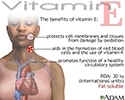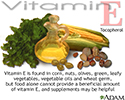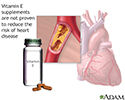Vitamin E
Alpha-tocopherol; Gamma-tocopherol
Vitamin E is a fat-soluble vitamin.
Function
Vitamin E is an antioxidant. This means it protects body tissue from damage caused by substances called free radicals, which can harm cells, tissues, and organs. They are believed to play a role in certain conditions related to aging.
The body also needs vitamin E to help keep the immune system strong against viruses and bacteria.
Vitamin E is also important in the formation of red blood cells and it helps the body use vitamin K . It also helps widen blood vessels and keep blood from clotting inside them.
Cells use vitamin E to interact with each other and carry out many important functions.
Whether vitamin E can prevent cancer, heart disease, dementia, liver disease, and stroke still requires further research
Food Sources
The best way to get the daily requirement of vitamin E is by eating food sources. Vitamin E is found in the following foods:
- Vegetable oils (such as wheat germ, sunflower, safflower, corn, and soybean oils)
- Nuts (such as almonds, peanuts, and hazelnuts/filberts)
- Seeds (such as sunflower seeds)
- Green leafy vegetables (such as spinach and broccoli)
- Fortified breakfast cereals, fruit juices, margarine, and spreads. Fortified means that vitamins have been added to the food. Check the Nutrition Fact Panel on the food label.
Products made from these foods, such as margarine, also contain vitamin E.
Side Effects
Eating vitamin E in foods is not risky or harmful. However, high doses of vitamin E supplements might increase the risk for bleeding and serious bleeding in the brain.
High levels of vitamin E may also increase the risk of birth defects.
Low intake may lead to hemolytic anemia.
Recommendations
The Recommended Dietary Allowance (RDA) for vitamins reflect how much of each vitamin most people should get each day.
- The RDA for vitamins may be used as goals for each person.
- How much of each vitamin you need depends on your age and gender.
- Other factors, such as pregnancy, breast-feeding, and illnesses may increase the amount you need.
The Food and Nutrition Board at the Institute of Medicine Recommended Intakes for Individuals for vitamin E:
Infants (adequate intake of vitamin E)
- 0 to 6 months: 4 mg/day
- 7 to 12 months: 5 mg/day
Children
- 1 to 3 years: 6 mg/day
- 4 to 8 years: 7 mg/day
- 9 to 13 years: 11 mg/day
Adolescents and Adults
- 14 and older: 15 mg/day
- Pregnant teens and women: 15 mg/day
- Breastfeeding teens and women: 19 mg/day
Ask your health care provider which amount is best for you.
The highest safe level of vitamin E supplements for adults is 1,500 IU/day for natural forms of vitamin E, and 1,000 IU/day for the man-made (synthetic) form.
References
Institute of Medicine. Food and Nutrition Board. Dietary Reference Intakes for Vitamin C, Vitamin E, Selenium, and Carotenoids . National Academy Press, Washington, DC, 2000. PMID: 25077263 www.ncbi.nlm.nih.gov/pubmed/25077263 .
Mason JB. Vitamins, trace minerals, and other micronutrients. In: Goldman L, Schafer AI, eds. Goldman's Cecil Medicine . 24th ed. Philadelphia, PA: Elsevier Saunders; 2011:chap 225.
Salwen MJ. Vitamins and trace elements. In: McPherson RA, Pincus MR, eds. Henry's Clinical Diagnosis and Management by Laboratory Methods . 22nd ed. Philadelphia, PA: Elsevier Saunders; 2011:chap 26.
-
Vitamin E benefit - illustration
Vitamin E is an important nutrient that helps your body in a variety of ways. You should get enough from a healthy, balanced diet. However, high amounts (400 IU) may be harmful.
Vitamin E benefit
illustration
-
Vitamin E source - illustration
Because most of the food sources of vitamin E are foods that aren't consumed in large amounts, a therapeutic level of vitamin E may be achieved only with supplements.
Vitamin E source
illustration
-
Vitamin E and heart disease - illustration
There is no conclusive evidence that taking vitamin E supplements can reduce your risk of heart disease. In fact, taking vitamin E supplements may actually be harmful.
Vitamin E and heart disease
illustration
-
Vitamin E benefit - illustration
Vitamin E is an important nutrient that helps your body in a variety of ways. You should get enough from a healthy, balanced diet. However, high amounts (400 IU) may be harmful.
Vitamin E benefit
illustration
-
Vitamin E source - illustration
Because most of the food sources of vitamin E are foods that aren't consumed in large amounts, a therapeutic level of vitamin E may be achieved only with supplements.
Vitamin E source
illustration
-
Vitamin E and heart disease - illustration
There is no conclusive evidence that taking vitamin E supplements can reduce your risk of heart disease. In fact, taking vitamin E supplements may actually be harmful.
Vitamin E and heart disease
illustration
-
Vitamin E
(Alt. Medicine)
-
Possible Interactions with: Vitamin E
(Alt. Medicine)
Review Date: 2/2/2015
Reviewed By: Emily Wax, RD, The Brooklyn Hospital Center, Brooklyn, NY. Also reviewed by David Zieve, MD, MHA, Isla Ogilvie, PhD, and the A.D.A.M. Editorial team.




